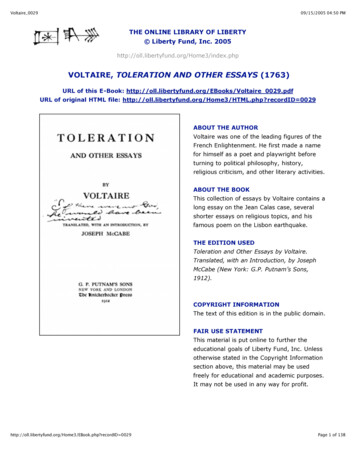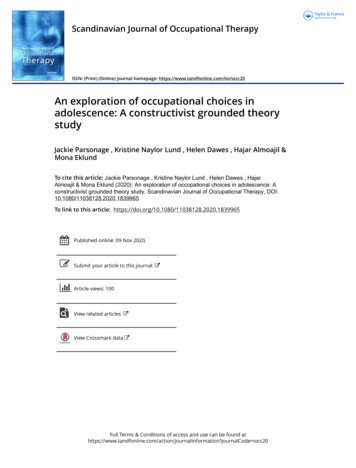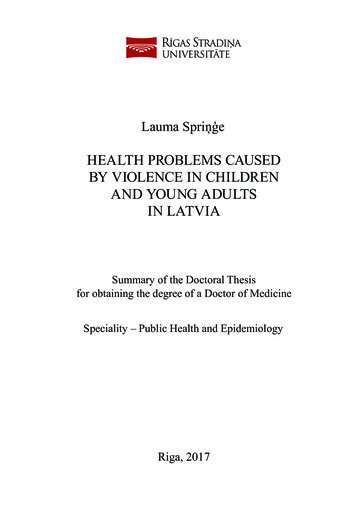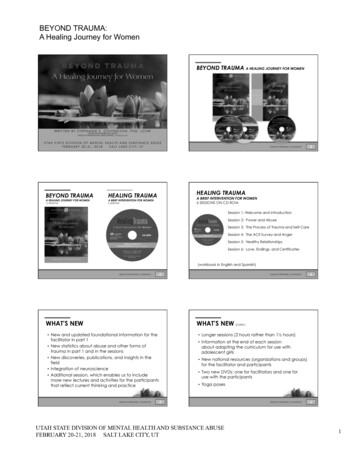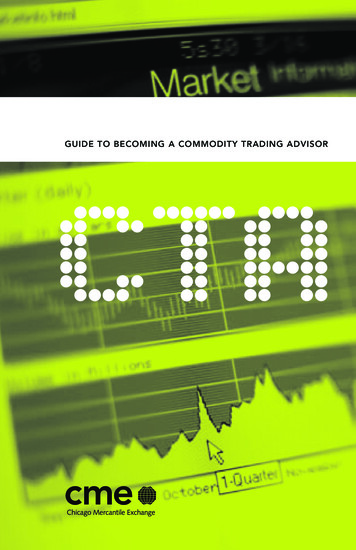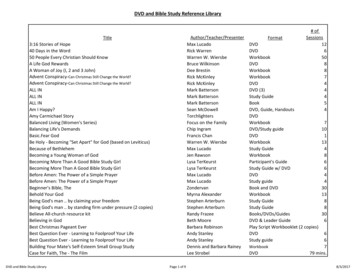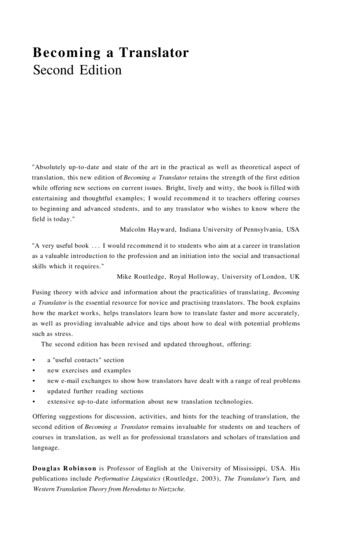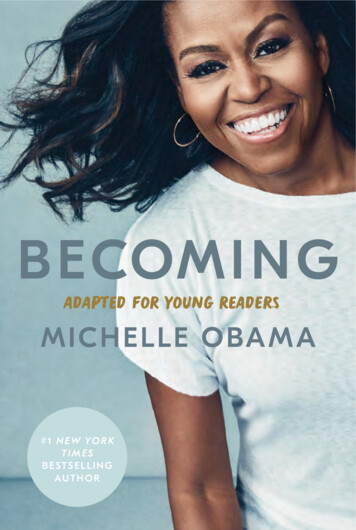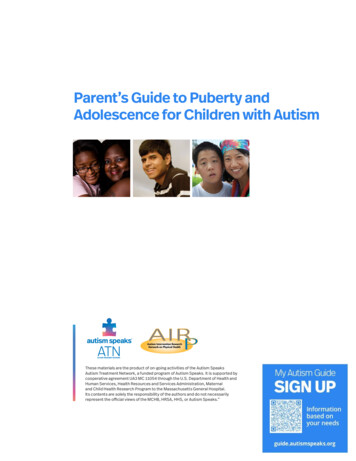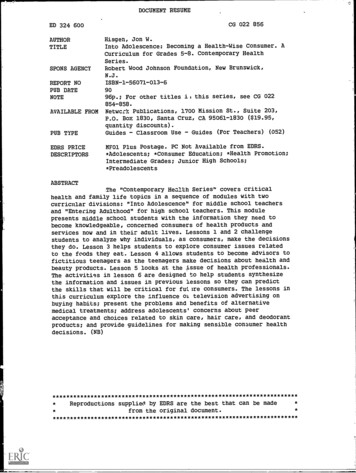
Transcription
DOCUMENT RESUMECG 022 856ED 324 600AUTHORTITLESPONS AGENCYHisgen, Jon W.Into Adolescence: Becoming a Health-Wise Consumer. ACurriculum for Grades 5-8. Contemporary HealthSeries.Robert Wood Johnson Foundation, New Brunswick,N.J.REPORT NOPUB DATENOTEAVAILABLE FROMPUB TYPEEDRS PRICEDESCRIPTORSISBN-1-56071-013-69096p.; For other titles il this series, see CG 022854-858.Netwcrk Publications, 1700 Mission St., Suite 203,P.O. Box 1830, Santa Cruz, CA 95061-1830 ( 19.95,quantity discounts).Guides - Classroom Use - Guides (For Teachers) (052)MF01 Plus Postage. PC Not Available from EDRS.*Adolescents; *Consumer Education; *Health Promotion;Intermediate Grades; Junior High Schools;*PreadolescentsABSTRACTThe "Contemporary Health Series" covers criticalhealth and family life topics in a sequence of modules with twocurricular divisions: "Into Adolescence" for middle school teachersand "Entering Adulthood" for high school teachers. This modulepresents middle school students with the information they need tobecome knowledgeable, concerned consumers of health products andservices now and in their adult lives. Lessons 1 and 2 challengestudents to analyze why individuals, as consumers, make the decisionsthey do. Lesson 3 helps students to explore consumer issues relatedto the foods they eat. Lesson 4 allows students to become advisors tofictitious teenagers as the teenagers make decisions about health andbeauty products. Lesson 5 looks at the issue of health professionals.The activities in lesson 6 are designed to help students synthesizethe information and issues in previous lessons so they can predictthe skills that will be critical for futire consumers. The lessons inthis curriculum explore the influence ol television advertising onbuying habits; present the problems and benefits of alternativemedical treatments; address adolescents' concerns about peeracceptance and choices related to skin care, hair care, and deodorantproducts; and provide guidelines for making sensible consumer healthdecisions. **************************Reproductions supplied by EDRS are the best that can be made*from the original *********************************
INTO ADOLESCENCE:Becoming aHealth-Wise-Consumer
INTO ADOLESCENCE:Becoming aHealth-Wise ConsumerA Curriculum for Grades 5-8Jon W. Hisgen, MSContemporary Health SeriesKathleen Middleton, MS, Series EditorNetwork Publications, a division of ETR Associates1990Santa Cruz, CA
Network Publications' Contemporary Health SeriesInto Adolescence (for grades 5-8)Choosing AbstinenceEnhancing Self-EsteemLearning About AIDSLearning About Reproduction and BirthLiving in a FamilyA Time of Change (puberty)Avoiding DrugsCommunicating EmotionsBecoming a Health-Wise ConsumerMaking and Keeping FriendsLiving Without TobaccoEntering Adulthood (for grades 9-t2)Connecting Health, Communication and Self-EsteemCoping with Sexual PressuresLiving in RelationshipsPreventing Sexually Related DiseaseUnderstanding Reproduction, Birth and ContraceptionBalancing Stress for SuccessUnderstanding Depression and SuicideExamining Drugs and RisksDeveloping Responsibility and Self-DisciplinePlanning Life Directions 1990 by Network Publications, a division of ETR Associates.All rights reserved. Published by Network Publications,P.O. Box 1830, Santa Cruz, CA 95061-1830.Printed in the United States of America10 9 8 7 6 5 4 3 2 1Cover design: Julia ChiapellaIllustrations:p. 13, 35, 77, 79, 89, 91: Steven Bairdp. 17, 19, 47, 49, 59, 63, 75: Ann SmileyTitle No. 378Library of Congress Cataloging-In-Publication DataHisgen, Jon W.Into adolescence: becomincl a health-wise consumer/Jon W. Hisgen.(The contemporary health series)"A Curriculum for grades 5-8"Bibliography: p.1. Health education (Elementary). 2. Consumer education (Elementary). 3. Health productsJuvenile. I. TitleII. Series.LB3408.H38ISBN 1-56071-013-6This curriculum was made possible, in part, by a grant from the Walter S. Johnson Foundation. The opinionsexpressed in this curriculum are those of the author and do not necessarily reflect the opinions of the Walter S.Johnson Foundation.
CONTENTSEditors onal StrategiesTeacher ResponsibilitiesGroundrulesEvaluative MethodsLesscis1. Cure or Quackery?2. We Are Because We Buy3. Think Before You Eat4. Will They Like Me More?.;. Medical Care Choices6. Consumer Health Choices: The Future Is YoursAppendixReferencesvii12233566729557193111123
7-7reMPSIMINAKONSVIVUP.4;.--DEDICATIONThis book is dedicated to my grandfather, whose consumer healthexperiences made me acutely aware of our need to be questioning,concerned Rurchasers of health products and services.JI-17
EDITOR'S PREFACEContemporary Health SeriesHealth educators and practitioners know that prevention of health problems is far more desir-able than treatment. The earlier the knowledge and skill to make healthful decisions areinstilled, the greater the chance a healthful lifestyle will be adopted. School is the logical placein our society to provide children, adolescents and young adults the learning opportunitiesessential to developing the knowledge and skills to choose a healthful life course.The Contemporary Health Series has been designed to provide educators with the curriculartools necessary to challenge students to take personal responsibility for their health. The longrange goals for the Contemporary Health Series are as follows:Cognitive Students will recognize the function of the existing body of knowledge pertainingtc health and family life education.Affective. Students will experience personal growth in the developrrmt of a positiveconcept and the ability to interact with others.Practice. Students will gain skill in acting on personal decisions about heait-,choices.ceWithin the Contemporary Health Series there are two curricular divisions: Into Ado IFfor middle school teachers and Entering Adulthood for high school teachers. The IntoAdolescence modules focus on several different health and family life topics. Modulesaddressing puberty, AIDS, the family, self-esteem, reproduction and birth, sexual abstinence,and drug, alcohol and tobacco education have been developed by skilled author/educators.Into Adolescence?: Becoming a Health-Wise Consumer8invii
Entering Adulthood includes reproduction, birth and contraception, health behavior, communication and self-esteem, AIDS and other STDs, relationships, sexual abstinence, and drug,alcohol and tobacco education.All the authors are, or have bc.,en, classroom teachers with particular expertise in each of thetopic areas. They bring a unique combination of theory, content and practice resulting incurricula which weave educational learning theory into lessons appropriate , for the develop-mental age of the student. The module format was chosen to facilitate flexibility as the modulesare compatible with each other but may stand alone. Finally, ease of use by the classroomteacher has driven the design. The lessons are comprehensive, key components are clearlyidentified and masters for all student and teacher materials are provided.The Contemporary Health Series is intended to help teachers address critical health issuesin their classrooms. The beneficiaries are their students, our children, and the next generation.Kathleen Middleton, MS, CHESSeries Editorviiin Into Adolescence: Becoming a Health-Wise Consumer
INTRODUCTIONTo this day, I vividly remember seeing my grandfather lying under It." It was a deep marooncolor. The whirling fan inside gave it an aura of mystery. Grandfather was precise in performinghis ritual at ten, two and four almost every day. He would place the maroon beam right on hisvery large pimple. And still I saw the pimple get larger and larger.Finally, Grandfather went to the hospital. Surgery was performed and his ear was removed. Hedied a month later in tremendous pain. You see, that pimple was cancer and that treatment wasquackery. Grandfather was sold a bill of goods by a man named Dinshah Ghadiali, and his lifewas cut short by that quackery.Upon entering the University of Wisconsin, I took an introductory health class and saw a pictureof the Spectochrome that my grandfather had used. I was determined not to let what happenedto my grandfather happen to future generations. This module is written in tribute to theunknowing consumer and with the hope that educators can help future consumers becomeinformed health purchasers.The curriculum has been designed to stimulate the interest of middle school students inconsumer choices. The underlying purpose is to encourage students to become knowledgeable, concerned users of health products and services in their adult lives.Have fun implementing these lessons. The key to the effectiveness of these lessons and of allhealth education is you, the classroom teacher.Into Adolescence: Becoming a Health-Wise Consumer101111
OverviewLessons 1 and 2 challenge students to analyze why we, asdo.consumers, make the decisions weIn Lesson 3, students explore consumer issues related to the foods we eat.In Lesson 4, students become advisors to fictitious teens as the teens make decisions abouthealth and beauty products.Lesson 5 looks at the issue of health professionals.The activities in Lesson 6 are designed to help students synthesize theinformation and issuesin previous lessons so they can predict the skills that will be criticalfor future consumers.ObjectivesLesson 1Cure or Quackery?III Students will be able to analyze the impor-tance of consumer health choices that theycurrently make.el Students will be able to describe the impact ofadvertising on the sale of health products andservices.Lesson 2We Are Because We Buya Students will be able to describe the influenceof television advertising for grooming andhealth care products on adolescents.Students will be able to identify some influences on their buying habits.Lesson 3Think Before You Eat1111111Lesson 4Will They Like Me More?Students will be able to analyze nutritionalinformation found on food labels.Students will be able to identify questionablenutritional claims.Students will be able to identify some beneficial products for skin tare and hair care.III Students will be able to differentiate betweenantiperspirant and deodorant products.2 a Into Adolescence: Becoming a Health-Wise Consumer
Lesson 5M Students will be able to use appropriate criteria to evaluate health care personnel 1 henMedical Care Choicesseeking trelment for various medical problems.Lesson 6Consumer Health Choices:The Future Is YoursStudents will be abIJ to evaluate the personalskills necessary tc make wise consumer healthch;Jices.TimeclassThe time indicated for each lesson is an approximate measure, based on a 45-50 minutedependingpeilod. The actual time required to complete all activities in a given lesson will va7y,on student interest and ability. Lessons that will probably require more than one class periodto complete are indicated.Instructional StrategiesThis module incorporates a variety of instructional strategies designed to develop and maintainstudent interest and motivation. Some strategies are traditional, while others are moreinteraclive, encouraging students to help each other learn. The specific strategies used in eachlesson are clearly identified An alphabetical list of instructional strategies and their descriptionfollows:BrainstormingClass DiscussionCooperative Learning GroupsCreative WritingForced Field AnalysisInterviewingOverhead TransparenciesTeacher LectureWorksheetsBrainstormingBrainstorming is used to stimulate discussion of an issue or topic. Students are asked to givetheir ideas and opinions without comment or judgment from the teacher or other studens. Ideascan be listed on the chalkboard, on butcher paper or newsprint or on a transparency.Brainstorming should continue until all ideas have been exhausted ora predetermined time limithas been reached.Class DiscussionA class discussion !ed by the teacher is one of the most valuable strategies used in education.It can be used to initiate, amplify or summarize a lesson. Most of the lessons in this moduleinclude some form of class discussion.Cooperative Learning GroupsCooperative learning is one of the most common and effective strategies used in this module.Into Adolescence: Becoming a Health-Wisa ConsumerI3
Students work in small groups to disseminate and share information, analyze ideas or solveproblems. The size of the group depends on the nature of the lesson and the make-up of theclass. Groups work best with two to six members.Group structure will affect the success of the lessons. Groups can be formed by student choice,random selection or a more formal, teacher-influenced xocess. Groups seem to function bestwhen they represent the variety and balance found in the classroom. Groups also work betterwhen each student has a responsibility within the group (reader, recorder, timer, reporter, etc.).While groups are working on their tasks, the teacher should move from group to group,answering questions and dealing with any problems that arise. At the conclusion of the groupprocess, some closure should take place.Creative WritingAsking students to write short stories or poems about topics they are studying integrateslanguage arts and personal experience into a lesson. This technique can be used as a followup to most lessons.Forced Field AnalysisThis strategy is used to discuss an issue that is open to debate. Students analyze a point of viewthat is likely to receive approval by some students and objections by others. For example, if thesubject of discussion was the American diAt, some students might support the notion thatAmericans consume healthy foods because of the wide variety of foods available. Otherstudents might express concern about the amount of foods high in sodium, fat and sugar thatare included in the American diet.Questioning skills are critical to the success of this technique. A good way to open such adiscussion is to ask students, "What questions should you ask to determine if you support oroppose this idea?" The "pros" and "cons" of the students' analysis can be charted on thechalkboard, on butcher paper or newsprint or on a transparency.InterviewingIn the quest for information on a topic, it is sometimes helpful to invite expertsinto the class orto interview others (family members or friends) outside of class. Advance preparation for anorganized interview session increases the learning potential. A brainstorming session beforethe interview allows students to develop individual questions to ask during the interview.Overhead TransparenciesOverhead transparencies are an effective visual aid to use in presenting information andgraphic examples. Most of the lessons in this module provide teacher resources that can beused as transparencies.4IN Into Adolescence: Becoming a Health-Wise Consumer13
Teacher Lecturethe teacher to students. InA traditional teacher lecture disseminates information directly frominformation. Generally, this method issome lessons, this approach is the best way to providecombined with other methods to assure high-level motivation and learning.Worksheetscomplete theMost lessons in this module include worksheets. Students may be asked toworksheets individually* o r in cooperative learning groups. Some worksheets include an activitygenerally be reviewed with theto be completed outside of class. Completed worksheets shouldwhole class to provide relevant and timely feedback.Teacher Responsibilitieslife. We start very youngEvery American makes consumer health choices throughout his or hermer choices,to become contributing consumers of society. Five year olds are influencing consueven if they are not actually purchasing items. Whether it is purchasing shampoo or acnemedication or visiting an orthodontist, we face a life filled with choices that affect our health.Teachers must dealwith these issues in a sensitive way. A range of attitudes and practices exists around manyvariety of viewpoints.issues. Teachers must acknowledge that range and be sensitive to theAs with other topics in health, consumer health issues can be controversial.alternatives toOne example is the range of treatment philosophies that could be considereddiagnosis, prescription,the standard American medical model. The standard model involveschiropractic havetherapy or surgery. However, medical alternatives such as acupuncture ora rightful place in our health-consuming society.how to cure disease,What students and educators must understand is that we are still learningbase.The information wehow to best maintain health and how to have a stable emtionalassume to be true today may be proved untrue tomorrow.informed and toThis has an enormous impact on consumer choices. The challenge is to staychoicesandthoseof the future.use critical thinking skills in making both today's consumerI have outlined five major guidelines that I think are essential for teachers to follow whenconducting these lessons:believe asAccept all ideas from students, even though they may be contrary to what youa consumer.Communicate the idea that people from all health care specialities, including medicaldoctors, have offered questionable treatments.Emphasize that wise consumers listen carefully to all ideas and make decisionc basedon information from a variety of sources.Into Adolescence: Becoming a Health-Wise Consumer E145
Note that effective consumers are familiar with a variety of health information sources.Do not diminish the beliefs and ideologies of others.GroundrulesTo help maintain a sensitive and positive atmosphere, classroom groundrulesshould beestablished before beginning the lessons in this modu:3.It is usually helpful if students participate in the process of identifying the groundrulesthey agreeto follow during the. lessons. One very important groundrule is that students have the righttopass on any question they feel is too personal for class discussion.Evaluative MethodsEach lesson provides the teacher with one or more methods for evaluating student performance on stated objectives. The methods are listed following the Procedure section of eachlesson. Evaluative methods include analysis and comment on worksheets and other writtenmaterials, as well as observation of individual responses.It is impossible to objectively, quantitatively or qualitatively measure the development andmaintenance of personal awareness and the ability to make consumer choices. Furthermore,it is inappropriate to grade student work when it is based on personal feelings, beliefs orbehaviors. Therefore, the evaluation methods serve as tools to assess students' participationan i cognitive learning from each lesson.6El Into Adolescence: Becoming a Health-Wise Consumer15
LESSONCURE OR QUACKERY?1ObjectivesStudents will be able to analyze the importance of consumer healthchoices that they currently make.Students will be able to describe the impact of advertising on thesale of health products and services.TimeOverviewTwo class periods.Throughout history, men and women have purchased productsand services to enhance their well-being. Some of these productsand services have been accepted by the general population; thevalue of others is often questioned. Many products, such as overthe-counter weight-loss products, offer a quick fix and claim to helppeople, but arp generally not effective. This lesson exploreswhether a product or service is a wise consumer choice. It also'looks at the difference between choices students are now makingInto Adolescence: Becoming a Health-Wise Consumer in17
meiffesabout health products and services and choices they will make inthe future.In this lesson, students are introduced to the world of quackerythrough a re-enactment of a medicine show. They explore consumer heafth issues through discussions and group work, analyzing the consumer habits of a fictitious extinct PreparationBrainstorming, class discussion, cooperative learning groups,worksheets.HAVE:st Overhead projector.COPY:Medicine Show worksheet, one for each student.Cunsumer Health Choices worksheet, one for each student.MAKE:Transparency of Quack Machine.Transparency of Common Clues to Quackery.Transparency of Why Quackery Thrives.PREPARE:Medicine Show Bottle Labeluse an antique medicine bottleor glue a label on a used bottle as described on the teacherpage.A Box of Artifacts, from Directions for Making a Box ofArtifacts.REVIEW:Teacher Background Information./ Medicine Show worksheet to prepare story.8 N Into Adolescence: Becoming a Health-Wise Consumer7
Proceduree The object of this first activity is to attempt to sell each studenta bottle of Dr. Chamberlain's Compound, a fictitious medicine,using a stereotypical medicine man approach. Show students themedicine bottle you have prepared, and tell them the story from theMedicine Show worksheet. You will be presenting a sales pitch fora worthless product. Play the part of the salesperson. Try toconvince students that they can't live without this product.Note: During the past five years, about 90 percent of my studentshave agreed to bring the money for the product the next day; 70percent have actually brought the money.After spending some time on the sales pitch, reveal to students thatthe product is not real and the sales pitch was an act. Students maybe upset, hurt or angry when told that your story is a hoax. A followup discussion is essential.It may be useful to discuss personal experiences with purchasesthat were not what you expected based on the advertising. Explainto students the anger you felt about these purchases. Help students understand that this is a common experience.After the story and sales pitch have been presente0, distribute theMedicine Show worksheet. Ask students the follow ng questions:How many believed the presentation before you told themthat it was a fictitious story?At what point in the story did students decide it wasn't true?Are any of today's ads similar to the presentations of themedicine shows of the 19th century? Why?E Divide the class into four groups, and ask each group to answerdifferent questions about the medicine show activity.Group AWhat methods did I use to try to sell you this product?(Possible responses include the following: special offer,famous people, mysterious ingredient, sympathy for the littleguy, magazine ads and successful sales.)Are these techniques used today? If so, how?Group BIf you developed a product for kids your age, what advertisingstyles would you use? Where would you advertise?Into Adolescence: Becoming a Health-Wise Consumer'48i9
Group CWhat types of products would you develop to sell to studentsyour age? Why did you choose these products?Group DHow can the consumer tell the difference-between a helpfulproduct and a quack product?Reconvene the class and discuss group responses to the questions.II Brainstorm about what makes a wise consumer choice. Usethis information as a guideline for the following activity. Dividestudents into groups of four or five. Ask each group to choose a representative.Show students the Box of Artifacts. Tell them that in the box aresome items that represent the remains of a fictitious society that nolonger exists. The students are scientists who have stumbled uponan item that will tell us something about the society.Have the representative of each group choose an artifact from thebox to share with her or his group. Tell groups to discuss whetherthe item represents a wise consumer choice. Tell students to usethe artifacts as clues to learn more about the society. Ask them todescribe the factors that may have led to the downfall of thissociety.Lead a class discussion about the similarities between this extinctsociety and our own. The following questions can be used:How is our health like an old pair of jeans? (Both areconstantly being repaired and wear out if not cared for. Withproper care, they can last a long time.)Why does our society ask people to make choices thatprevent health problems? (Health insurance costs are high;the cost of Veating illness is much higher than that ofpreventive health care.)If you were to change ony artifact in the box, what would it be?Why?What artifacts of today's world would you like future generations to find? Why?1111 Show students the Quack Machine transparency. Tell themabout some of the fraudulent machines advertised for medical10 I Into Adolescence: Becoming a Health-Wise Consumer9
cures, including those mentioned in Teacher Background Infor-mation.II Discuss the types of medical problems for which quack treatments are most likely to be offered (major killers and pain causerslike cancer, arthritis or heart disease).II Show students the transparency of Common Clues to Quackery, and discuss the points with them.Explain that we live in a world where billions of dollars are spenteach year on fraudulent health products. Surveys indicate thatabout 15 percent of the American population used a fraudulenthealth product or service in 1988. About 10 percent of the peoplewho used these treatments suffered negative side effects fromtheir use.Display the Why Quackery Thrives transparency. Tell studentsthat this is a list of six of the ten leading health frauds in the UnitedStates. Use the transparency to frame a class discussion abouthealth fraud. If necessary, first discuss the meaning of the wordfraud.EvaluationDistribute the Consumer Health Choices worksheet. Ask students to consider the importance of the health products andservices they are presently using and to predict future changes intheir consumer health choices.When students have completed the worksheet, lead a classdiscussion around the following questions:Why do adults make different health choices than middleschool students? (Health concerns change; adults see theirlives moving quickly; adults have more money.)Which of your choices do you think will change in 20 years?Why?In the year 2000, will young people make different consumerhealth choices? If so, which choices may change and why?Is there an important health choice not listed on the worksheet? What is it?How are consumer health choices like shopping for cereal?(Some are good-tasting but not nutritious, while others areInto Adolescence: Becoming a Health-Wise Consumer I2011
not very tasty but Nalthful.)How does advertising impact consumer choices?HomeworkTell students to develop a medical device and an accompanying ador slogan to sell it. The device could be designed to treat any medicalproblem, from the common cold to a rare disease.During another class period, discuss the students' machines. Askstudents to explain how the device will work and how they plan topromote and sell the product, using the techniques discussed in thelesson. Note:This assignment could be done as a cooperative groupassignment if yEN.: choose.2112 M Into Adolescence: Becoming a Health-Wise Consumer
1.'It,"Teacher Background InformationHealth for Salelit our credit card culture, instant pleasures are only a signatuna away. There is no betterexample of this "John Hancock" approach to consumer decisions than in the world of healthproducts and services. We often blindly use hit-or-miss tactics for everything-from wiping outthose unsightly blemishes with steam to strengthening our rectus abdominous muscle withelectric belts.The ability to be a wise consumer of health products and services is not easily acquired, butmust be learned. Some consumers have realized the impact of their choices for health productsand services only after lives have been threatened in some way. For example, only after twowomen suffered miscarriages using the Relaxicisor was criminal action taken against Relaxicisor, Inc. of California. The makers of Renulife claimed that the then-mysterious element ofelectricity could cure any medical problem.The Renulife MachineInto Adolescence: Becoming a Health-Wise Consumer22N 13
The use of a single device that could cure most of man's ills began early in the health quackerybusiness. Some of these early devices, such as the Roche electric machine and the nenulife,claimed that use of the then-mysterious element of electricity could cure any medical problem.Devices like the Spectrochrome made use of colored lights to reportedly cure "all diseasesknown to man." When Dinshah Ghadiali came to the United States in the 1920s, he boughthismedical degree for 333.33. He then proceeded to sell the Spectrochrome throughout theUnited States for two decades.As his "cure" for diabetes, for example, he prescribed brown sugar and coloredlight treatmentsthree times a day. He was finally brought into court for prescribing this dangerous treatment andsubsequently fined and deported.The medicine show is a slice of Americana. Medicine producers used a medicine show (muchlike a circus sideshow) to sell their drugs in cities and towns across the United States. Theypromoted their products with song and dance as well as humor.They also used staged testimonials (people who would stand and proclaim thewonders of theproduct). Many of these shows ran in conjunction with fairs and evolved intoevenings ofvaudeville entertainment. It was all capped off with a feverish sales pitch.In 1950, former Louisiana state senator Dudley J. LeBlanc revived the medicine showapproach, selling an elixir called Hadacol. He put on huge tent shows, with an averageattendance of ten thousand patrons. LeBlanc sold his business in 1951 for 8million dollars.He claimed to have sold 75 million dollars worth of the product.Hadacol was mostly alcohol, with some vitamins and minerals added, sweetened withhoney.LeBlanc claimed it cured all ills. Even without scientific data to support LeBlanc's claim, millionsof people bought the product, making him a very wealthy man.14 I Into Adolescence: Becomi
This book is dedicated to my grandfather, whose consumer health . Into Adolescence: Becoming a Health-Wise Consumer 111 1. 1 0. Overview. Lessons 1 and 2 challenge studentsto analyze why we, as consumers, make the decisions we do. In Lesson 3, students explore consumer issues related to the foods we eat.
